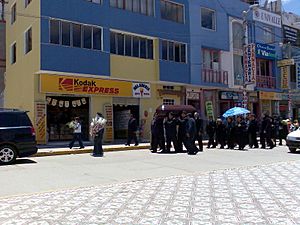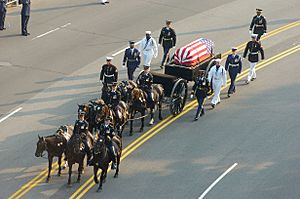Funeral facts for kids

A funeral is a special ceremony held when someone has died. It's a time for friends and family to gather. They come together to feel and show sadness, which is called mourning. They also remember and give thanks for the life the person lived.
Often, the body of the person who died is present, usually inside a coffin. Sometimes, the coffin is open so people can see the person one last time. After the funeral, the body is usually buried in the ground or cremated (burned). A memorial service or celebration of life is like a funeral, but the body is not there.
Contents
Why We Have Funerals
People in all cultures around the world hold funerals. Religion often plays a big part in these customs. Many funerals include prayers for the person who died. These prayers ask for their soul to find peace and have a good journey in the afterlife.
Funerals also help the friends and family of the person who died. Here are some reasons why:
- They help people accept that the person is truly gone. This allows them to start getting used to life without that person.
- It's a chance to say goodbye. Many people don't get to say goodbye before someone dies.
- Mourners can support each other. They realize they are not alone in their sadness.
- It's a time to think about life and death.
- People can share happy memories of the person's life.
Today, funerals have changed a lot. Many services now focus more on celebrating the life of the person. They are not just about the sadness of death.
Funeral Traditions Around the World
A funeral ceremony can happen in many places. These include a church, a temple, a special building for funerals, or even at home.
In North America, a visitation (also called a viewing or wake) is common. This happens a few days before the funeral. People are invited to see the body during this time.
In Madagascar, there's a ritual called famadihana. This means "the turning of the bones." Every five or seven years, families dig up the remains of their ancestors. They clean the bones and spray them with perfume or wine. Then, they take the skeleton home to dance with it. This also helps introduce the ancestors to younger family members.
In Bali, following Hindu tradition, the soul is believed to restart its rebirth cycle after cremation. Balinese cremation, called Ngaben, uses an open fire to burn the body. This memorial often feels like a celebration. It focuses on the happy life of the person who passed away.
Common Funeral Practices
Several things often happen at a funeral in Western countries:
- A procession is when the coffin travels to or from the funeral. Today, a special car called a hearse usually carries the coffin.
- A eulogy is a speech that tells the story of the person's life.
- Prayers are often said. These include prayers of thanks for the person's life. They also ask for the person's soul to rest in peace and enter the afterlife. Prayers are also said to help the mourners move forward with their lives.
- Singing hymns (religious songs) is common.
- The committal is when the body disappears. At Christian funerals, a preacher might say, "earth to earth, ashes to ashes, dust to dust." This means the body returns to the ground.
- At a burial, the coffin is taken to the grave and lowered into it. Mourners might throw dirt onto the coffin. This symbolizes the body returning to the earth.
- For cremation, mourners usually don't watch the burning. The coffin might be hidden by curtains near the end of the service.
- Music that the person loved is often played.
Many modern funerals include a video tribute. This video might play before, during, or after the service. Memorial folders or prayer cards are often given out. These also help make the funeral personal. It's common to see a "life reflection" table at funerals. Family members might bring favorite pictures or other items that remind them of the person. Different religions have many unique traditions.
Images for kids
-
Peasant funeral in the Mam Turk mountains of Connemara, Ireland, 1870
-
Funeral of Indian Syro-Malabar Catholic, Venerable Varghese Payyappilly Palakkappilly on 6 October 1929.
-
A Hindu cremation rite in Nepal. The samskara above shows the body wrapped in saffron red on a pyre.
-
The lying in state of a body (prothesis) attended by family members, with the women ritually tearing their hair (Attic, latter 6th century BCE)
-
A western-style funeral motorcade for a member of a high-ranking military family in South Korea.
-
John Everett Millais – The Vale of Rest
-
Medieval depiction of a royal body being laid in a coffin.
-
A funeral parade of Marshal Mannerheim in Helsinki, Finland, on February 4, 1951. Helsinki Lutheran Cathedral on the background.
-
Traditional "crossed-ladders" for a fire department funeral
-
Funeral procession in Beijing, 1900
See also
 In Spanish: Funeral para niños
In Spanish: Funeral para niños


























